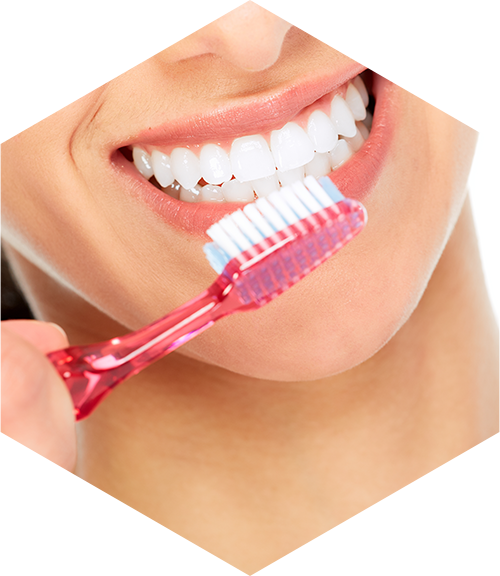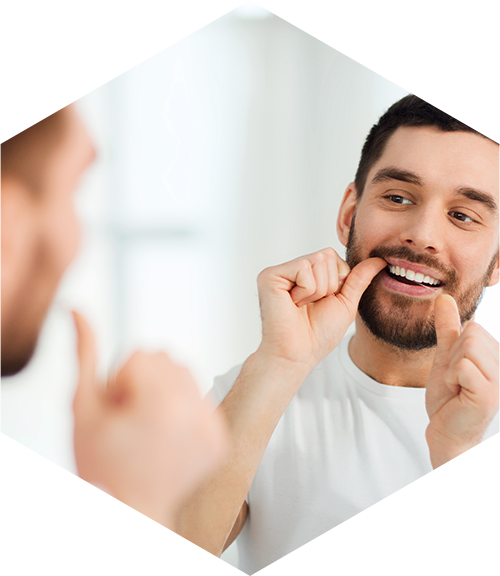
Preventative Dentistry Austin, TX
Prevent disease and decay through preventative dentistry.
Preventative dentistry means to take care of all the routine cleaning and tooth maintenance, before cavities and tooth decay ever have a chance to form. With proper medical care and direction, we can reach this goal with all our patients.
As we do our part with regular cleanings and health assessments, don’t forget that the most important care is the everyday routine of brushing and flossing. So, read below to brush up on some oral health information and tips!
- Prevent disease through regular exams and teeth cleanings.
- Detect cancer in its early and most treatable stages with an oral cancer screening.
- Learn how to properly brush your teeth by reading our brushing tips.
- Learn how to properly floss your teeth by reading our flossing tips.

Exams and Cleanings
Good for more than just your teeth!
When you visit our Austin dental office for that routine hygiene appointment, our team does a lot more than just probe for cavities. In addition to caring for your teeth, we’re giving you the next best thing to a complete physical examination. If it’s been a while since you’ve seen your family physician, it just could prove a lifesaver!
How’s that possible?
Your mouth is a unique meeting place of teeth, skin, muscle, fluids, and germs. It gives us the chance to look inside your body without surgery. Over forty serious diseases, including bulimia, tumors, and AIDS, can be detected in the mouth. The texture, color, and condition of your tongue and gums can be evidence of high blood pressure or osteoporosis.
That’s why we encourage you to make at least two dental appointments every year, especially if you don’t get annual physical examinations.
We’re here to make sure your teeth stay in great shape. Along with the rest of your body.

Oral Cancer Screening
Early detection is key to successful treatment.
Oral Cancer is the fifth most common cancer in the world, it kills about one-third of those diagnosed with it, and 28,000 new cases occur each year. And over 25% of oral cancers occur in people who don’t smoke or have other lifestyle risk factors.
Trouble spots and oral lesions
Are there any red or white spots you haven’t noticed before? Maybe you’ve taken a wait-and-see approach to a small sore you found last week. Any unexplained swelling? Discoloration that doesn’t hurt a lick? Come on in; we need to see what you see.
Most oral lesions, as we call them, are harmless. A piece of crusty French bread with dinner can scratch delicate tissues. But if you use tobacco and alcohol, have or have had HPV, or are being treated for any number of systemic diseases—diabetes, autoimmune disorders among them—that harmless irritation is a red flag. During your dental appointment, we’ll take a closer look. When we find a lesion, suspicious or not, we intend to err on the cautious side.
Facts about oral cancer
- Accounts for 6% of all cancers
- Symptoms: white spots on gums, “sores that won’t heal”
- Typical victims: smokeless tobacco users; older men; alcohol drinkers
- More than 25% of cases occur in non-smokers under 40
- HPV plays a role in more than 20% of cases
- First to notice symptoms: often, the family dentist
- Early detection can lead to life-saving treatment

Brushing Tips
What is the best technique for brushing?
One effective, easy-to-remember technique involves using a circular or elliptical motion to brush a couple of teeth at a time, gradually covering the entire mouth. Place a toothbrush beside your teeth at a 45-degree angle and gently brush teeth in an elliptical motion. Brush the outside of the teeth, inside the teeth, your tongue, and the chewing surfaces and in between teeth. Using a back and forth motion causes the gum surface to recede, or can expose the root surface or make the root surface tender.
Soft or hard bristles?
In general, a toothbrush should have soft, nylon bristles with round ends. Some brushes are too abrasive and can wear down teeth, so medium and hard bristles are not recommended. A soft, rounded, multi-tufted brush cleans teeth effectively with minimal risk of damage. Electric toothbrushes are also effective. The bristles of the electric brush should be placed against the teeth and gums and moved systematically over the teeth allowing the brush to do its job.
How long should I brush?
It might be a good idea to brush with the radio on, since we generally recommend brushing 3-4 minutes—the length of an average song. Patients generally think they’re brushing longer, but most spend less than a minute brushing.
Should I brush at work?
It’s definitely a good idea to keep a toothbrush in your desk, since getting the debris off teeth right away stops sugary snacks from turning to damaging acids. If you brush with fluoride toothpaste in the morning and before going to bed, you don’t even need to use toothpaste at work. You can just brush and rinse before heading back to the desk. If you don’t have a toothbrush with you, rinsing your mouth with water for 30 seconds after lunch also helps.
The following tips may improve your brushing habits:
- Post a sticky note on your desk or computer at work as a reminder to brush teeth after lunch.
- Brush teeth right after lunch, before you become absorbed in work.
- Store a toothbrush and toothpaste at work in a convenient and handy place.
- Make brushing your teeth part of your freshening up routine at work.

Flossing Tips
Should I be flossing?
Yes. Floss removes plaque and debris that adhere to teeth and gums in between teeth, polishes tooth surfaces, and controls bad breath. Floss is the single most important weapon against plaque, perhaps more important than the toothbrush. Many people just don’t spend enough time flossing or brushing and many have never been taught to floss or brush properly. When you come to us for a visit just ask to be shown!
How should I floss?
There are two flossing methods: the spool method and the loop method. The spool method is suited for those with manual dexterity. Take an 18-inch piece of floss and wind the bulk of the floss lightly around the middle finger. (Don’t cut off your finger’s circulation!) Wind the rest of the floss similarly around the same finger of the opposite hand. This finger takes up the floss as it becomes soiled or frayed. Maneuver the floss between teeth with your index fingers and thumbs. Don’t pull it down hard against your gums or you will hurt them. Don’t rub it side to side as if you’re shining shoes. Bring the floss up and down several times forming a “C” shape around the tooth being sure to go below the gum line.
The loop method is suited for children or adults with less nimble hands, poor muscular coordination or arthritis. Take an 18-inch piece of floss and make it into a circle. Tie it securely with three knots. Place all of the fingers, except the thumb, within the loop. Use your index fingers to guide the floss through the lower teeth, and use your thumbs to guide the floss through the upper teeth, going below the gum line forming a “C” on the side of the tooth.
How often should I floss?
At least once a day. To give your teeth a good flossing, spend at least two or three minutes.
What about floss holders?
You may prefer a pre-threaded flosser or floss holder, which often looks like a little hacksaw. Flossers are handy for people with limited dexterity, for those who are just beginning to floss, or for caretakers who are flossing someone else’s teeth.
